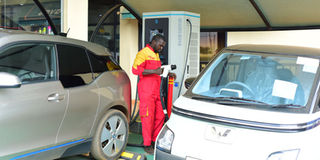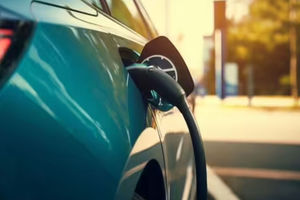
Latest data from Uganda Revenue Authority (URA) indicates a total of 1,694 e-units were imported into Uganda and only 17 vehicles and 910 motorcycles are 100 percent electric between 2022 and the first four months of 2024. PHOTO/MICHAEL KAKUMIRIZI
The automobile industry is rapidly and irreversibly shifting to electric vehicles, placing traditional gasoline and diesel cars in serious competition.
Electric cars use energy from a battery, converted into power by an electric motor to drive the wheels. The motor generates high torque, eliminating the need for a traditional transmission, and provides instant acceleration. This minimises energy loss and ensures all four wheels receive full power instantly, unlike traditional cars.
Electric cars conserve energy through regenerative braking. When you lift your foot off the accelerator, the car slows down, and some of the energy is returned to the battery. This extends the battery’s life and increases the vehicle’s range.
Several scientists, engineers, and researchers have discovered that this is the solution to the planet’s global warming. They are currently persuading global leaders, investors, politicians, and activists to allocate more funds in their production to lessen dangerous emissions from exhaust pipes.
The East Africa Venture Capital (EAVC) researchers expect Uganda to get “more capital commitments to renewables (solar energy), hydroelectricity, and e-mobility” this year as a result.
In 2023, the industry brought in $27.5 million (Shs103.8 billion) in fund-mediated deals, or 35 percent of the $78 million (Shs294.5 billion) in deal values in the nation for venture and private equity funding last year.
Adoption
The ownership of electric cars has increased. The latest data from Uganda Revenue Authority (URA) indicates a total of 1,694 e-units were imported into Uganda and only 17 vehicles and 910 motorcycles are 100 per cent electric between 2022 and the first four months of 2024.
This is just a segment of the at least 42,000 vehicles that Uganda imported in 2020. This number is projected to hit 90,000 by 2030.
Companies like Motorcare Uganda are selling 14 electric cars and getting inquiries from prospective buyers including government and private individuals.
Kiira Motors Corporation, another auto maker, has sold 28 buses this year.
The world’s biggest electric vehicle (EV) manufacturers, including Tesla, Rivian Automotive, General Motors, and Ford, are all reporting slow sales, which they primarily attribute to production costs, insurance costs and low distribution of charging network infrastructure.
In addition, consumers are increasingly concerned that the current cost of electric cars will decrease due to the introduction of new, improved models and price reductions by other companies to increase sales.
“It’s getting to be a very difficult task of selling EVs from the pricing stand point,” former Ford chief executive officer Mark Fields, said early this year in a televised interview.
He added that even mass production is difficult because adoption is still low.
“The purchase of an EV is completely discretionary. This is because of price cuts, low residual value expectations, and an economy that is somewhat uncertain. From a pricing standpoint, it could be a tough year for selling EVs. Automakers are going to make a choice: do they cut prices to stimulate demand or will they live with underutilization of their plants? Either way, they are poised to hit their margins.”
Motorcare imports some of these electric vehicles into Uganda and sells vehicles like a Nissan model in a range of between $57,000 (about Shs214.9 million) and $98,000 (about Shs369.5 million).
Manufacturing
Kiira Motors Corporation (KMC) is the industry’s mover in manufacturing. It makes electric automobiles such as coaches, buses and vehicles.

Kiira Motors anticipates that as the government makes greater investments in the country’s mineral sector, it will be able to source steel domestically, particularly from the country’s iron ore. PHOTO/MICHAEL KAKUMIRIZI
Government records indicate that as of April 2023, the company has invested a minimum of Shs312.45 billion.
Other players include Zembo, GOGO, Bodawerk and Tondeka Metro Bus Company.
KMC is manufacturing electric cars at a National Enterprise Corporation facility in Nakasongola as it awaits the completion of its plant three months away. It has been hindered by operating at half capacity, but its goal is to manufacture 5,000 vehicles annually and install about 1,500 electric chargers in the East African region.
“We are interested in other technology partners from all over the world to come and partner with us because without the charging system being sufficient to support the cars on the road, it will be very hard to adopt the electric vehicle technology,” says Fred Matovu, the Electrics &Electronics systems manager, Kiira Motors.
The company is producing a 58-carrier bus with 28 standing and another 28 seating configurations for city travel, with a nominal range of 200km on default and custom orders. But it is deterred by funding and policy reforms.
Its executives are requesting Shs134.14 billion more to bring its Jinja vehicle plant into operation.
A section of the National Assembly believes this is unjustified given the long delay in its commercialisation.
The company says the current electric vehicle importation tax-free incentive, which eliminates taxes on imported electric cars and raises the prices of the cars it puts on the market is discouraging uptake of its products.
It has been in talks with the government to avert this since 2020, “because one of the key barriers to electric vehicle adoption is the uptake that is pegged on the price. The best way to reduce the cost is for us to reduce the production cost. This requires us to reduce the cost of inputs,” according to Thatcher Nakimuli Mpanga, the product design manager of Kiira Motors.
Budget
During the Budget speech, the Finance Minister allocated Kira Motors Shs32.5 billion for the completion of the manufacturing plant in Jinja Industrial Park, which is expected to produce 2,500 vehicles per year.

Finance Minister Matia Kasaija. PHOTO/FILE
Kasaija said: “The complex has so far manufactured 39 buses of which 27 are electric and 12 are low-emission diesel. The company has orders for more than 100 buses from Tanzania, South Africa, Eswatini (formerly Swaziland), and Nigeria. This demonstrates the huge market potential for the vehicles.”
The company pays premiums for some of the parts it imports that it cannot make locally. This has pushed it to talk with the government to lower them for over four years now.
While presenting the Budget speech, Finance Minister Matia Kasaija revealed that government services of electric motorcycles, vehicles manufactured or fabricated in Uganda and their respective charging stations and batteries for electric motorbikes, charging stations and related services are exempt from tax.
“That allows us attain competition and raises awareness of electric vehicles in the country. We told government that in order for you to increase domestic manufacturing, we need to encourage local manufacturers by removing the Value Added Tax (VAT) because the market had already started saying that the product is expensive,” she said.
“We have received parliamentary approval on electric VAT exemption on our vehicles that stops clients from paying the VAT on our products which brings down the cost of our vehicles. Additionally, we have secured the VAT exemption as a manufacturer of electric vehicles. Some of those exemptions have been provided by the Ministry of Finance and have been approved by Parliament ready to roll out in the next financial year,” she added.
This part of the reason why the cheapest electric vehicle at KMC stands at $30,000 (Shs113.3 million).
“Uganda wants to produce 500,000 buses by 2040. If we push out VAT, we shall save 30 percent of $200,000. That is around $140,000. For small cars, it is $30,000,” Ms Nakimuli said.
The company’s flagship model is a 12-, 13-, and 17-metre bus. It also features a long-distance coach with a length that alternates between 10 and 12 metres. Currently, it plans to develop SUVs and pickup trucks as well.
But the parts sourced within Uganda are only 18 percent of most of the company’s Kayoola buses.
Kiira Motors anticipates that as the government makes greater investments in the country’s mineral sector, it will be able to source steel domestically, particularly from the country’s iron ore, lowering the price of its cars since steel is one of its biggest imports.
Since bulk mineral mining and processing would increase production costs, the company does not want to pursue this course of action.
To leverage the country’s mineral resources, like cobalt, which is a crucial component in the priciest part of electric vehicles—the batteries—KMC has already purchased land in the Kayunga district to establish an automotive industry park. Manufacturers of these components will be setting up shop there and supply the automaker with car components.
Charging infrastructure
Kiira Motors is currently dealing with a charging infrastructure shortage that prospective customers frequently inquire about, as it already has products on the market and intends to produce electric cars in large quantities later this year.
There are just three fast chargers in place, one at the Kiira plant in Jinja, another at Luwero Industries, and the third in the Bugolobi Industrial area parking lot.
However, Eng Ian Kavuma, the quality inspections manager at KMC, says the company has procured nine more fast chargers from the 60kw charger, 180kw chargers and the 360kw chargers.
“Each of these are double gun to cut down the charging time basically. This means by the end of the year, we should be having approximately 13 to 14 fast chargers on the network to facilitate both short term and long term travel,” he said.
There are three chargers at KMC, two at Total Energies, and one at the US Embassy for private vehicles. Only KMC possesses large vehicles such as buses.
Cost of using it
According to engineers at Kiira Motors, owning and purchasing an electric car entails the majority of costs, which can be reduced by 60 percent, right after that.
“Considering the current price per kilowatt of industrial power which is Shs348. It has a consumption rate of approx. 1 Kw per kilometre. You are basically using 94,000 for a journey of 263 km,” said Eng Kavuma.
“We are in talks with the Civil Aviation Authority to have the airside of buses there fully electric. We are in close talks with Total for electrification, the Ministry of Works, and Energy as well to have charging stations planted along the major highways,” he added.
To manage power on your electric car, you do the best routing depending on the power you have on your battery and switch off all associated accessories, he advised.

A man charges a hybrid electric vehicle at a charging point in Kamwokya. Uganda Revenue Authority indicates a total of 1,694 e-units were imported into Uganda. PHOTO/MICHAEL KAKUMIRIZI
Electricity
The Electric Vehicle Database data shows that the energy consumption of electric vehicles averages out to around 0.32 kilowatt-hours (kWh) per mile. So for every mile driven, an EV will consume 0.32 kWh of electricity.
Electricity access is still low in Uganda. With a population of about 48 million people, only 57 percent of those have access to electric power according to Electricity Regulatory Authority.
Uganda would need to double its electricity generation capacity if this pattern holds in the future.
With its current installed capacity of 1,402 MW, Uganda would require approximately 13,000 GWh to meet its e-mobility demand, industry experts calculate.
With its current installed capacity of 1,402 MW, Uganda would require approximately 13,000 GWh to meet its e-mobility demand, industry experts calculate.
According to Irene Batebe, Permanent Secretary in the Energy Ministry, the government is investing in five commercial charging stations in line with the country’s energy efficiency drive.



